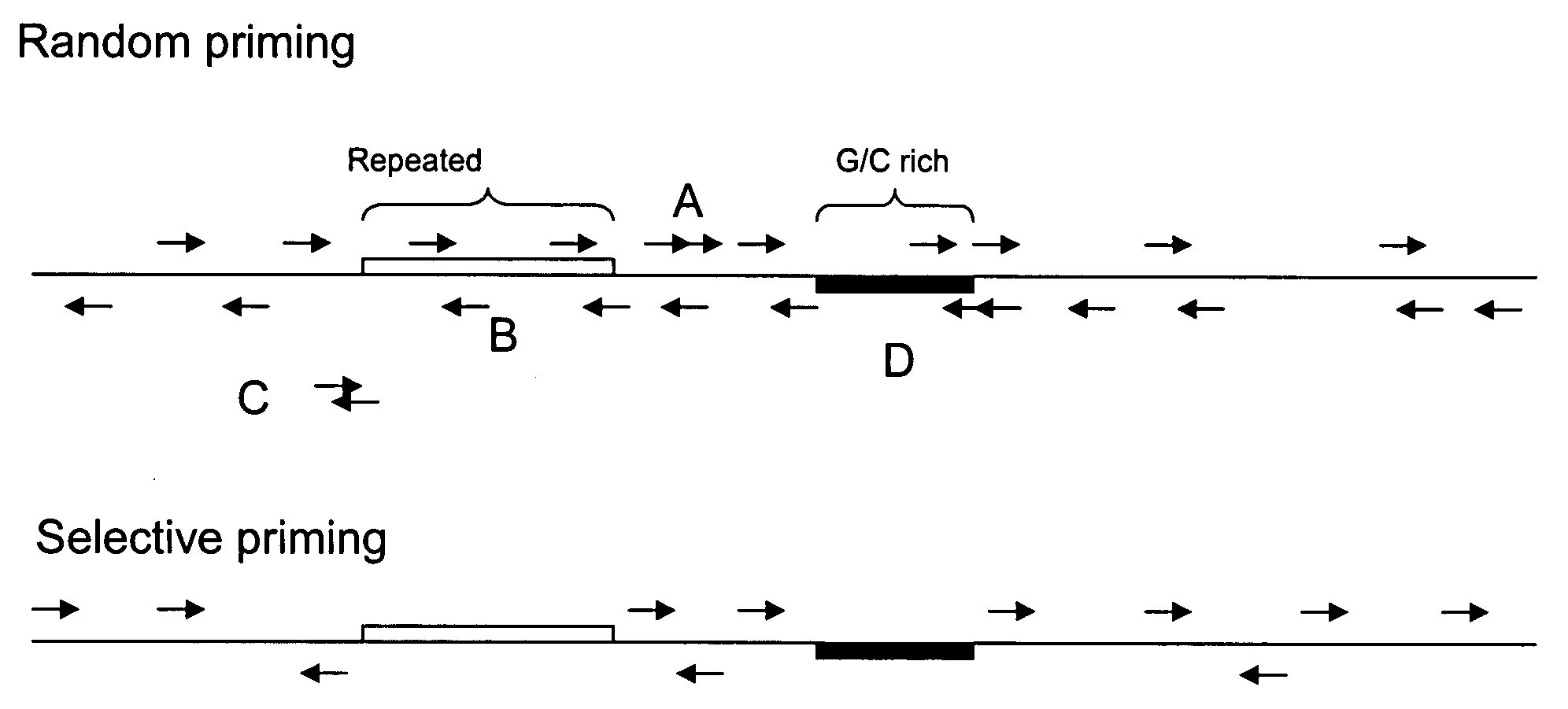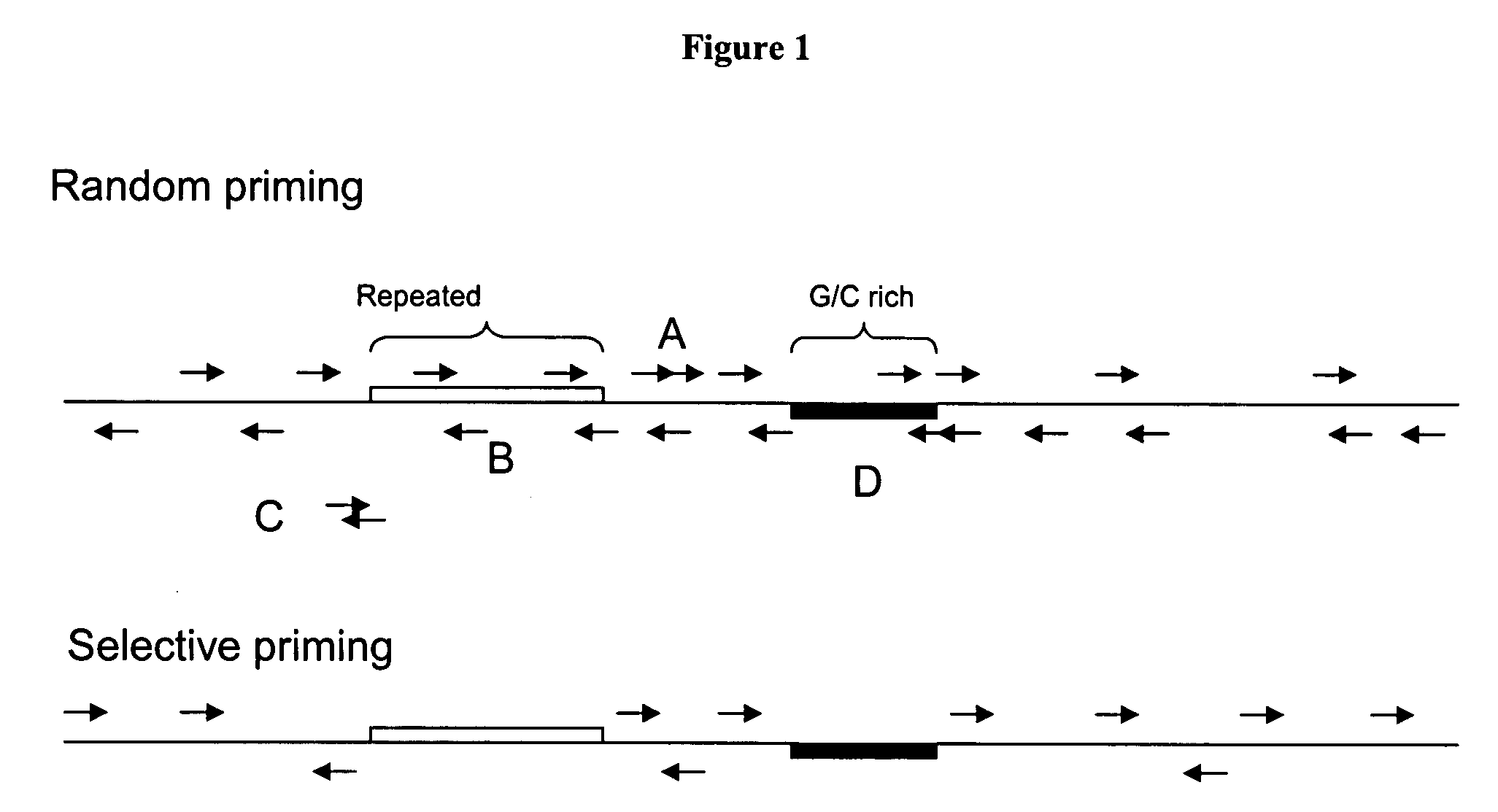Complex oligonucleotide primer mix
a technology of complex oligonucleotide and primer mix, which is applied in the direction of organic chemistry, sugar derivatives, etc., can solve the problems of reducing signal, causing data noise, and suffering from the same problems as probes
- Summary
- Abstract
- Description
- Claims
- Application Information
AI Technical Summary
Benefits of technology
Problems solved by technology
Method used
Image
Examples
example 1
Generating Probes for Fluorescence In Situ Hybridization
[0073]A method is exemplified for generating probes for Fluorescence In Situ Hybridization. There is interest in creating more specific FISH probes (Mora et al., Mol. Cell Probes 2006, 20: 114-120). The exemplified probes can also be adapted for other cytogenetic techniques, such as Fiber-FISH, Comparative Genomic Hybridization (CGH), Representative Oligonucleotide Microarray Analysis, Primed In Situ Labeling, etc.
Method
[0074]A region of DNA (“the target”) is chosen to probe. In this example, a region of the human genome is chosen. Primers are designed that bind in the target region. The primers avoid highly repeated regions. Primer design strategies and algorithms are well known. These strategies are adapted to design the probe primers for FISH. A complex mixture of primers is synthesized. The primers are synthesized on a glass surface, such as in Agilent's in situ synthesis microarray printing process. The synthesized oligonu...
example 2
Oligonucleotide Photocleavage
[0076]Ink-jet microarrays comprising the oligonucleotides are described herein (see U.S. Pat. Nos. 6,419,883 and 6,028,189). The oligonucleotides are attached to the substrate via photocleavable phosphoramidite monomers. In addition, phosphoramidite monomers separate the primers on the oligonucleotide. Oligonucleotides are cleaved in 1 ml of 25 mM Tris-buffer solution (pH 7.4) by situating the array in direct contact with a UV irradiation source at a wavelength of 302 nm for 20 min.
example 3
DNA Labeling and FISH
[0077]This protocol is for use with chromosomal hybridization. Labeling 25-50 ng of template DNA will produce enough probe to detect a single-copy gene on a single slide of chromosome spreads. The total DNA to be labeled can be calculated according to the number of individual slides which are to be probed. To detect repeat sequences, less than 50 ng of probe DNA / slide is necessary to produce a good hybridization signal. The amount required depends on the number of gene copies. For single-copy gene detection, the template should preferably be cosmid or yeast artificial chromosome (YAC) DNA in order to generate sufficient signal; however, templates as small as 15 kb can be used successfully. Miniprep DNA can be used as a template, provided that an RNase step is included in the preparation protocol.
Labeling Procedure
[0078]The reaction buffer is prepared by mixing 8 μl of fluor-12-dUTP with 92 μl of 5× nucleotide buffer in a sterile microcentrifuge tube. In two sepa...
PUM
| Property | Measurement | Unit |
|---|---|---|
| Tm | aaaaa | aaaaa |
| Tm | aaaaa | aaaaa |
| Tm | aaaaa | aaaaa |
Abstract
Description
Claims
Application Information
 Login to View More
Login to View More - R&D
- Intellectual Property
- Life Sciences
- Materials
- Tech Scout
- Unparalleled Data Quality
- Higher Quality Content
- 60% Fewer Hallucinations
Browse by: Latest US Patents, China's latest patents, Technical Efficacy Thesaurus, Application Domain, Technology Topic, Popular Technical Reports.
© 2025 PatSnap. All rights reserved.Legal|Privacy policy|Modern Slavery Act Transparency Statement|Sitemap|About US| Contact US: help@patsnap.com


